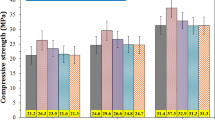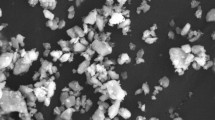Abstract
In this investigation the effect of addition of magnetite nanoparticles on the hydration characteristics of both ordinary Portland cement (OPC) and high slag cement (HSC) pastes was studied. The cement pastes were prepared using a water/solid (W/S) mass ratio of 0.3 with addition of 0.05, 0.1, and 0.3 % of magnetic fluid Fe3O4 nanoparticles by mass of cement. An aqueous stable magnetic fluid containing Fe3O4 nanoparticles, with a mean diameter in the range of super-paramagnetism, was prepared via co-precipitation method from ferrous and ferric solutions. The admixed magnetite-cement pastes were examined for compressive strength, chemically combined water content, X-ray diffraction analysis, and differential scanning calorimetry. The results of compressive strength revealed that the hardened pastes made from OPC and HSC admixed with different amounts of magnetic fluid have higher compressive strength values than those of the neat cement OPC and HSC cement pastes at almost all ages of hydration. The results of chemically combined water content for the admixed cement pastes showed almost the same general trend and nearly comparable values as those of the neat cement pastes. From the XRD diffractograms obtained for the neat OPC and HSC cement pastes, the main hydration products identified are calcium silicate hydrates, portlandite, and calcium sulfoaluminate hydrates. Addition of magnetic fluid nanoparticles to both of OPC and HSC did not affect the main hydration products of the neat OPC or HSC cement in addition to one main basic difference, namely, the formation of calcium iron hydroxide silicate as a new hydration product with a reasonable hydraulic character.









Similar content being viewed by others
References
Bhushan B, editor. Handbook of nanotechnology, Springer; Berlin 2004.
El-Hosiny FI, El-Diasty F, El-Said HM, Ismail MIM. Hydration characteristics of admixed magnetite nanoparticles-cement pastes. Third international conference on nanotechnology in construction, (HBRC). 2011. 14–17 Mar 2011, Cairo, Egypt.
Maile Aiu. The chemistry and physics of nano-cement. Loyola Mary Mount University, Advisor: Dr. C.P. Huang Submitted to: NSF-REU University of Delaware (2006); August 11.
Li H, Xiao H, Yuan J, Ou J. Microstructure of cement mortar with nanoparticles. Compos: B Eng. 2004;35(2):185–9.
Poole CP, Owens FJ. Introduction to nanotechnology. New York: Wiley; 2003.
Zhang W-X, Wang C-B, Lien H-L. Treatment of chlorinated organic contaminants with nanoscale bimetallic particles. Catal Today. 1998;40(4):387–95.
Chan WCW, Maxwell DJ, Gao X, Bailey RE, Han M, Nie S. Luminescent quantum dots for multiplexed biological detection and imaging. Curr Opin Biotechnol. 2002;13(1):40–6.
Watanabe T, Kojima E, Norimoto K, Kimura T, Machida M, Hayakawa M, Kitamura A, Chikuni M, Saeki Y, Kuga T, Nakashima Y. Multi-functional material with photo catalytic functions and method of manufacturing same. US patent US6294247, 2001.
Ginebra MP, Driessens FCM, Planell JA. Effect of the particle size on the micro and nanostructural features of a calcium phosphate cement: a kinetic analysis. Biomaterials. 2004;25(17):3453–62.
Wen -Yih Kuo, Jong-Shin Huang, Chi-Hsien Lin. Effects of organo-modified montmorillonite on strengths and permeability of cement mortars. Cem Concr Res. 2006;36(5):886–95.
Li H, Xiao H, Ou J. A study on the mechanical and pressure sensitive properties of cement mortar with nanophase materials. Cem Concr Res. 2004;34(3):435–8.
Yamguchi K, Matsumoto K, Fiji T. Magnetic anisotropy by ferromagnetic particles alignment in a magnetic field. J Appl Phys. 1990;67:4493–5.
Odenbach S. Magnetic fluids. Adv Colloid Interface Sci. 1993;46:263–82.
Atarshi T, Imai T, Shimoiizaka J. On the preparation of the colored-water based magnetic fluids (red, yellow, blue and black). J Magn Magn Mater. 1990;85(1–3):3–6.
Fan R, Chen XH, Gui Z. A new simple hydrothermal preparation of nanocrystalline magnetite Fe3O4. Mater Res Bull. 2001;36(3–4):497–502.
Zhang DE, Tong ZW, Li SZ, Zhang XB, Ying AL. Fabrication and characterization of hollow Fe3O4 nanosphere in microemulsion. Mater Lett. 2008;62(14):4053–5.
Jiang WQ, Yang HC, Yang SY, Horng HE, Hung JC, Chen YC, et al. Preparation and properties of supermagnetic nanoparticles with narrow size distribution and biocompatible. J Magn Magn Mater. 2004;283(2–3):210–4.
Zins D, Cabuil V, Massart R. New aqueous magnetic fluids. J Mol Liq. 1999;83(1–3):217–32.
Zhi Ge and Zhili Gao. Applications of nanotechnology and nano materials in construction. First international conference on construction in developing countries (ICCIDC-I). advancing and integrating construction education, research & practice. 4–5 Aug 2008, Karachi, Pakistan; 2008.
Hanehara S, Ichikawa M. Nanotechnology of cement and concrete. J Taiheiyo Cem Corp. 2001;141:47–58.
Scrivener KL. Nanotechnology and cementitious materials. In: Bittnar Z, Bartos PJM, Nemecek J, Smilauer V, Zeman J, editors. Nanotechnology in construction: proceedings of the NICOM3 (3rd international symposium on nanotechnology in construction). Prague; 2009. p. 37–42.
Sobolev K, Ferrada-Gutiérrez M. How nanotechnology can change the concrete world. Part 2. Am Ceram Soc Bull. 2005;84(11):16–9.
Sobolev K, Shah SP. SP-254 Nanotechnology of concrete: recent developments and future perspectives. Detroit: American Concrete Institute; 2008.
Bartos PJM, de Miguel Y, Porro A, editors. NICOM: 2nd international symposium on nanotechnology for construction. Bilbao: RILEM Publications SARL; 2006.
Bittnar Z, Bartos PJM, Nemecek J, Smilauer V, Zeman J, editors. Nanotechnology in construction: proceedings of the NICOM3 (3rd international symposium on nanotechnology in construction). Prague. Berlin: Springer; 2009. p. 438.
El-Diasty Fouad, El-Said HM, El-Hosiny FI, Ismail MIM. Complex susceptibility analysis of magneto-fluids: band gap and surface studies on the nano-magnetite-based powders. Curr Opin Solid State Mater Sci J. 2009;13:28–34.
AI-Khalaf MN, Yousift HA. Use of rice husk ash in concrete. Int J Cem Comp Lightweight Concr. 1984;6(4):241–8.
Amin MS, Habib AO, Abo-El-Enein SA. Hydrothermal characteristics of high slag cement pastes made with and without silica sand. Adv Cem Res. 2012;24(1):23–31.
El-Gamal SMA, Hashem FS, Amin MS. Thermal resistance of hardened cement pastes containing vermiculite and expanded vermiculite. J Therm Anal Calorim. 2011;109(1):217–26.
Hashem FS, Amin MS, El-Gamal SMA. Improvement of acid resistance of Portland cement pastes using rice husk ash and cement kiln dust as additives. J Therm Anal Calorim. 2012;. doi:10.1007/s10973-012-2458-4.
Chaipanich A, Nochaiya T. Thermal analysis and microstructure of Portland cement–fly ash–silica fume pastes. J Therm Anal Calorim. 2010;99:487–93.
Nochaiya T, Wongkeo W, Pimraksa K, Chaipanich A. Microstructural, physical, and thermal analysis of Portland cement–fly ash–calcium hydroxide blended pastes. J Therm Anal Calorim. 2010;100:101–8.
Amin MS, Abo-El-Enein SA, Abdel Rahman A, Khaled AA. Artificial pozzolanic cement pastes containing burnt clay with and without silica fume: physicochemical, microstructural and thermal characteristics. J Therm Anal Calorim. 2012;107:1105–15.
Author information
Authors and Affiliations
Corresponding author
Rights and permissions
About this article
Cite this article
Amin, M.S., El-Gamal, S.M.A. & Hashem, F.S. Effect of addition of nano-magnetite on the hydration characteristics of hardened Portland cement and high slag cement pastes. J Therm Anal Calorim 112, 1253–1259 (2013). https://doi.org/10.1007/s10973-012-2663-1
Received:
Accepted:
Published:
Issue Date:
DOI: https://doi.org/10.1007/s10973-012-2663-1




